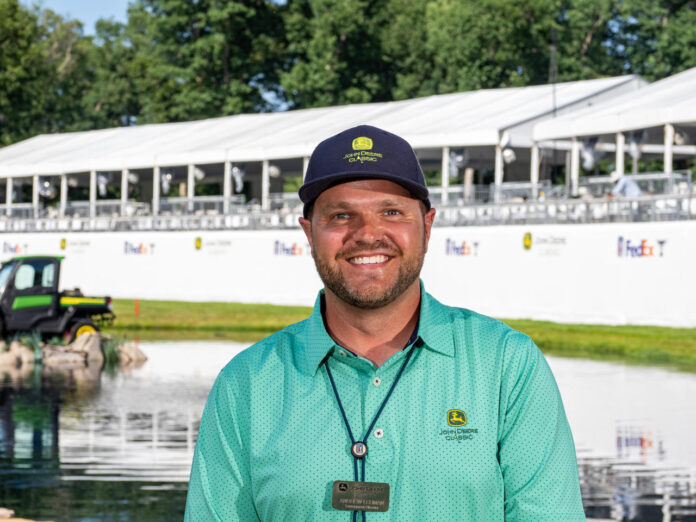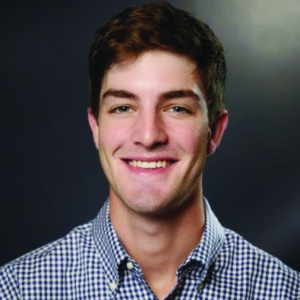
SILVIS – Pristine greens and flawless fairways are only part of what worldwide TV viewers see annually from the John Deere Classic.
Skyboxes, chalets and hospitality tents housing the cheering fans also serve as the backdrop at the local PGA Tour stop’s finishing holes.
And just to remind people where they are, massive earth-moving machines stamped with the title sponsor’s familiar logo and green-and-gold color scheme loom over the proceedings to glisten in the sun as if they just rolled off a local factory floor.
However, many of those TV viewers might be surprised to learn that TPC Deere Run only appears this way during tournament week each year.
“It’s a huge undertaking,” said Andrew Lehman, the JDC’s tournament director. “We’re building a small city on a golf course for one week until we tear it down and look forward to building It again next year.”
This made-for-TV town includes more than 200 tents and five truckloads of furniture – “Enough to furnish more than one mansion,” Mr. Lehman guessed.
“How many structures are there? That’s a hard question because you’ve got bleachers and all sorts of other things built especially for spectators to enjoy the tournament.”
Included in this year’s July 5-9 tournament week are six new hospitality venues added to Silvis golf course.
“We’re doing smaller, cabin-type venues between (holes) 15 and 17 that are meant for smaller hospitality groups,” Mr. Lehman said. “We’ve also got a new venue on the 15th green and a new venue on the 16th green.
“The 17th green remains the same, but the 18th green is where the new ‘Concerts on the Course’ are going to be Saturday and Sunday after play, so that is where the stage will be. We also have a new venue on 9, a new venue on the 18th, and then we are changing our bleacher on 1,” Mr. Lehman said.
“That bleacher always sat behind the tee. But the Tour built a new back tee box, which really kind of shortened us up. So, if you’ve seen other events on TV where they wrap the tee with a bleacher on one side and a bleacher in the back, that’s what we’re going to do and try to do.”
Even without so many new additions, Mr. Lehman said preparing TPC Deere Run for the tournament takes more than a month of work.
“From an agronomy standpoint, the maintenance team comes out of winter and they are nurturing and prepping for tournament conditions right away,” Mr. Lehman added. “Even though they have 51 other weeks of the year, our one-week event is their top priority. That (course) is their baby.”
The tournament staff feels the same pressure to deliver outside the ropes in terms of hospitality venues, spectator areas and vendors/displays.
On-course prep work began in mid-May with volunteers building the base of operations by installing electrical, phone and internet lines. By mid-June, Mr. Lehman said, the grunt work became a daily concern.
“We’re so blessed that a lot of that stuff is taken care of by volunteers,” he added. “It means not having to go out and hire a company to do that. We might be the only event that runs it that way and it’s again a testament to the fact that there is total buy-in from every constituent that’s part of this event.”
Before his maiden voyage as tourney director last year under the watchful eye of his retiring predecessor Clair Peterson, Mr. Lehman was the architect of this temporary golf town for more than a dozen years.
Now, Marshal Lamb is the JDC’s new tournament operations manager, and Mr. Lehman is the unofficial mayor of Magic City – with the JDC catchphrase being “Magic Happens Here.”

“The first thing (Marshal) did was get prepared for the first crew to arrive,” Mr. Lehman said. “You can’t build X until you have something else done. So, the first thing was marking the venues. You’ve always got to stay ahead of where they are building. If it’s a 42-by-32-foot structure, you’re marking that. We also have metal hubs in the ground, and we go out and find them with metal detectors.
“And so many times, your first vendor on site is the under-structure company. So, the steel that is the structure, those installation crews have to stay ahead so your tenting company can come in and then follow them at a pace. So, you really try to stick to a build plan and build schedule.”
Surprisingly, erecting the many structures is hardly the biggest challenge.
“We’ve got to sell it first if we want to build it,” Mr. Lehman said.
“We’re selling a concept. Neither I nor our sales director (Jennifer Kress) have an actual picture to show people. We have a rendering of what we envision,” he added. “And she’s so good at making sure she brings that storytelling to life when she’s having those conversations.
“And we are fortunate having support from community partners, which allows us to grow. We’re also always concepting and best practicing with other tournaments and seeing what works for them and how do we bring that to life here.”
The finishing touch also happens to be the biggest detail – both literally and figuratively. “The heavy equipment from Deere goes in the week before we play the tournament,” Mr. Lehman said.
“You try to leave yourself some wiggle room because that stuff is so heavy that if we have two days of rain, you’ve got to call an audible. And after you get it in place, there’s a company that comes in and details the machines to make sure they are shiny and look new. They also shine the tires and wipe it down every morning during the tournament so we make sure to put Deere in the best light.”




